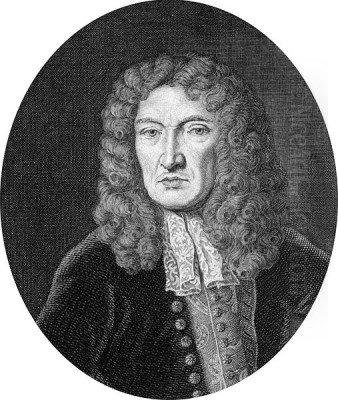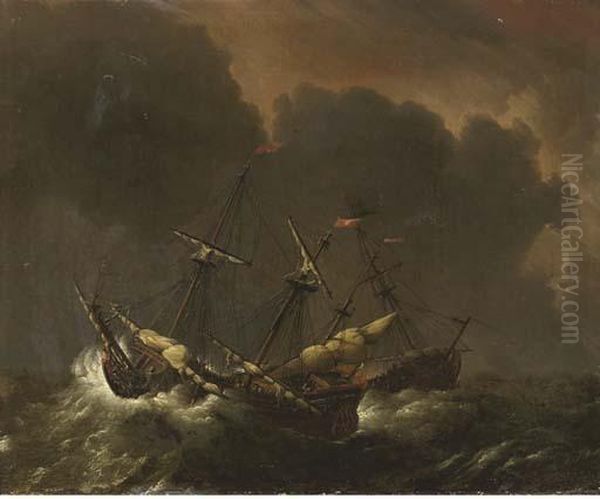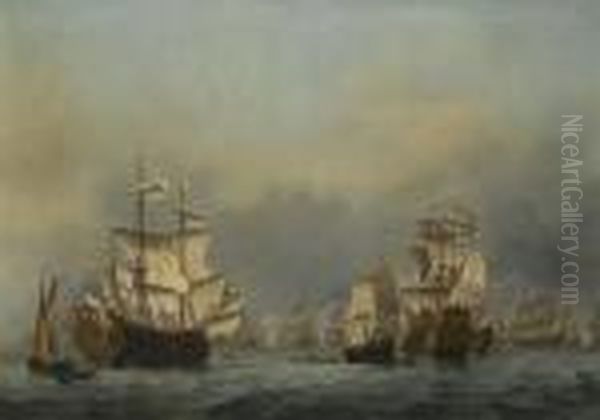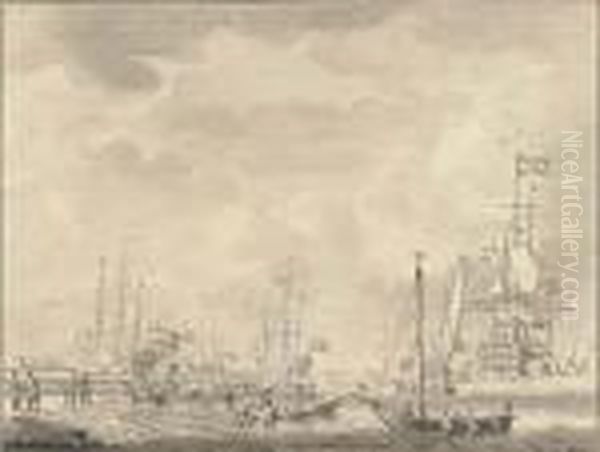
The Dutch Golden Age, spanning roughly the 17th century, witnessed an unprecedented flourishing of arts and sciences in the newly independent Dutch Republic. Among the most celebrated artistic genres of this era was marine painting, reflecting the nation's reliance on, and mastery of, the sea for trade, exploration, and warfare. Towering figures in this field were Willem van de Velde the Elder and his son, Willem van de Velde the Younger. Together, they created an unparalleled visual record of Dutch maritime life and naval power, establishing a dynasty that dominated marine art in both the Netherlands and later in England. Their meticulous detail, atmospheric depth, and dramatic compositions set a standard that influenced generations of artists.
Willem van de Velde the Elder: The Draughtsman
Willem van de Velde the Elder was born around 1611 in Leiden, a prominent city in the Dutch Republic. His father, Willem Willemsz. van de Velde, was reportedly a skipper from Flanders, suggesting an early familial connection to the sea. While details of his artistic training are scarce, Willem the Elder emerged as a highly skilled draughtsman specializing in maritime subjects. His primary focus during the early part of his career was not oil painting, but rather detailed drawings of ships, harbours, and naval engagements.
He gained recognition for his remarkable ability to render vessels with near-photographic accuracy. This skill was highly valued by the Dutch Admiralty and shipping companies, who often commissioned him to document important ships and naval events. His role often went beyond that of a studio artist; he became an official artist for the Dutch fleet, sometimes accompanying naval expeditions to sketch battles and manoeuvres firsthand from a small vessel called a galliot. This practice provided him with intimate knowledge of ship construction, rigging, and the dynamics of naval warfare.

His dedication to accuracy made his works invaluable historical documents. He meticulously recorded the appearance of specific warships, merchant vessels, and yachts, capturing the nuances of their design and decoration. His drawings often served as preparatory studies for larger works, including tapestries and paintings, sometimes executed by other artists or later by his son. He worked primarily in Amsterdam, the bustling hub of Dutch maritime activity.
The Elder's Technique: Penschilderij
Willem van de Velde the Elder was a master and pioneer of a unique technique known as penschilderij (pen painting). These were not simple sketches but highly finished monochrome works executed with pen and ink, usually on prepared panels or canvases primed with a light ground. The technique involved drawing intricate details with a fine pen, using delicate lines, cross-hatching, and stippling to create tone, texture, and the illusion of volume, mimicking the appearance of engravings.
These penschilderijen were laborious to create and were considered independent works of art, highly prized by collectors for their detail and technical virtuosity. They allowed Van de Velde the Elder to capture the complexity of ship rigging, the texture of wood and sail, and the subtle play of light on water with astonishing precision. This technique was particularly suited to his documentary approach, enabling him to record naval events with clarity and detail unmatched by broader oil painting techniques alone.
While Van de Velde the Elder is the most famous exponent of penschilderij, he was not entirely alone. Other artists, such as Heerman Witmont and Experientius Sillemans, also worked in this demanding medium, contributing to a niche but significant aspect of Dutch Golden Age art. However, Van de Velde the Elder's output and skill in this technique remain unparalleled. His works in this style provide a fascinating insight into 17th-century maritime life.
Willem van de Velde the Younger: The Painter
Born in Leiden in 1633, Willem van de Velde the Younger was destined to follow in his father's artistic footsteps, eventually surpassing him in fame as a painter. He received his initial training from his father, learning the fundamentals of ship drawing and gaining exposure to the maritime world. Crucially, he also studied for a period around 1650 with Simon de Vlieger in Weesp. De Vlieger was one of the most respected marine painters of his generation, known for his atmospheric depictions of coastal scenes and his mastery of light and water.

Under De Vlieger's guidance, Van de Velde the Younger honed his skills in oil painting, learning to translate the precise draughtsmanship inherited from his father into evocative, tonally sophisticated painted compositions. He developed a remarkable sensitivity to atmospheric effects – the quality of light, the movement of clouds, the texture of calm or stormy seas. While his father excelled in detailed documentation, the Younger became a master of capturing the mood and majesty of the ocean.
By the early 1650s, Willem the Younger was working independently, though often in close collaboration with his father in their Amsterdam studio. He quickly gained recognition for his paintings, which combined the accuracy learned from his father with the painterly qualities absorbed from De Vlieger. His works appealed to the growing market for marine paintings among wealthy Dutch merchants, naval officers, and civic institutions.
A Shared Studio and Early Success
For many years, the Van de Veldes, father and son, operated a highly successful studio in Amsterdam. Their collaboration was unique; the Elder often provided the detailed preliminary drawings based on his on-site sketches, while the Younger translated these into finished oil paintings. This division of labour allowed them to produce a large body of work efficiently, meeting the high demand for their art. However, the Younger also developed his own compositions and increasingly worked from his own sketches and imagination.
Their studio became the leading centre for marine art in the Netherlands. They documented key moments in Dutch naval history, including battles from the Anglo-Dutch Wars. Their patrons included admirals like Michiel de Ruyter and Cornelis Tromp, as well as the city authorities of Amsterdam. The family's artistic talent extended further; Willem the Younger's brother, Adriaen van de Velde (1636-1672), became a highly regarded landscape painter, known for his idyllic pastoral scenes and skillful depiction of animals and figures. Though Adriaen's subject matter differed, the family shared a commitment to careful observation and refined technique.
Other prominent Dutch artists were active during this period. Landscape painters like Jacob van Ruisdael, known for his dramatic land and seascapes, and Jan van Goyen and Pieter Molijn, known for their tonal landscapes, were contemporaries whose work reflected the Dutch fascination with their environment. In marine painting itself, artists like Jan Porcellis had earlier paved the way with more atmospheric, less detailed approaches, while Jan van de Cappelle excelled in serene harbour views, often featuring calm waters and luminous skies. Ludolf Bakhuizen would later emerge as a major competitor, particularly known for his dramatic storm scenes.
The Move to England

The political and economic climate in the Netherlands shifted dramatically in 1672, known as the Rampjaar (Disaster Year). The Republic was invaded by France under Louis XIV, and simultaneously engaged in the Third Anglo-Dutch War with England. This turmoil severely impacted the art market. Seeking stability and new patronage, Willem van de Velde the Elder and Younger made the momentous decision to relocate to England, likely in late 1672 or early 1673.
Their reputation preceded them, and they were welcomed by the English court. King Charles II, a known admirer of marine art and keen to promote England's naval prowess, quickly took them into his service. He granted them an annual pension of £100 each, a significant sum, specifically "for taking and making Draughts of Sea Fights" (for the Elder) and "for putting the said Draughts into Colours" (for the Younger). This formal arrangement solidified their position as official maritime artists to the English Crown.
They were provided with studio space in the Queen's House at Greenwich, a royal residence strategically located on the River Thames with views of shipping activity. This location, now home to the National Maritime Museum which holds a vast collection of their works, became the centre of their English production for the rest of their lives. Their move marked a significant transfer of artistic talent and profoundly influenced the course of marine painting in England.
Royal Patronage and English Career
Working for Charles II and later his brother and successor, James II (who was himself a former Lord High Admiral), the Van de Veldes documented key moments of English naval history, often depicting battles from the very wars that had prompted their departure from Holland. They produced numerous paintings and drawings of the English fleet, royal yachts, and ceremonial maritime events. Their patrons included not only the monarchy but also high-ranking naval officers and members of the aristocracy.
Their English works often maintained the high level of accuracy characteristic of their Dutch period, but sometimes adapted to suit English tastes, occasionally featuring brighter colours or more overtly dramatic compositions. They depicted battles such as the Battle of Solebay (1672) and the Battle of the Texel (1673), sometimes even revisiting earlier conflicts from both Dutch and English perspectives depending on the commission. The Younger, in particular, produced large-scale, elaborate canvases that adorned royal palaces and the homes of the elite.
Their presence in England provided a direct link to the sophisticated traditions of Dutch marine painting. English artists had previously engaged with maritime themes, but the Van de Veldes brought an unparalleled level of skill, realism, and atmospheric sensitivity. Their studio at Greenwich likely employed assistants to help cope with the demand for their work, further disseminating their style and techniques.
The Younger's Artistic Style and Themes
Willem van de Velde the Younger is widely regarded as the greatest marine painter of the Dutch Golden Age, and arguably one of the finest in European art history. His style is characterized by a remarkable synthesis of accuracy and artistry. He possessed an encyclopedic knowledge of ship construction and sailing, allowing him to depict vessels with convincing realism under various conditions. Yet, his paintings transcend mere documentation; they are imbued with a profound sense of atmosphere and light.
His mastery over depicting water in all its forms – calm and reflective, choppy and wind-blown, or raging in a storm – was exceptional. He rendered the subtle gradations of light in the sky, from the clear brilliance of a sunny day to the dramatic chiaroscuro of storm clouds, often using low horizons to emphasize the vastness of the sky and sea. His compositions are typically balanced and harmonious, even when depicting chaotic battle scenes. The arrangement of ships, the play of light and shadow, and the suggestion of wind and weather all contribute to the overall mood of the piece.
Van de Velde the Younger's thematic range was broad within the marine genre. He painted tranquil harbour scenes known as 'calms', often depicting ships at anchor in glassy water under serene skies. He excelled at portraying ships battling fierce gales, capturing the drama and peril of seafaring. His ship portraits meticulously detailed individual vessels, while his large battle pieces conveyed the complex choreography and brutal reality of naval warfare. Artists like Abraham Storck and Hendrick Dubbels worked in similar veins in the Netherlands, but Van de Velde the Younger's consistent quality and evocative power set him apart.
Masterpieces of Marine Art
The oeuvre of Willem van de Velde the Younger includes numerous masterpieces housed in major museums worldwide. Among his most celebrated works are:
The Cannon Shot (c. 1680, Rijksmuseum, Amsterdam): A quintessential example of a 'calm', this painting depicts a Dutch warship firing a salute in tranquil waters under a luminous sky. The stillness of the scene is palpable, broken only by the plume of smoke from the cannon. The reflections in the water and the delicate rendering of the ships are masterfully handled.
The Gust (c. 1680, Rijksmuseum, Amsterdam): In contrast to the calm, this work shows small vessels caught in a sudden squall. The dramatic sky, wind-filled sails, and choppy water convey the power of nature and the vulnerability of the boats. It showcases his ability to capture dynamic movement and weather effects.
Ships on a Stormy Sea (c. 1672, National Gallery, London): Painted around the time of his move to England, this work is a powerful depiction of ships struggling against towering waves and dark, menacing clouds. The dramatic lighting highlights the foam of the waves and the straining sails, creating a scene of intense maritime peril.
The Surrender of the Royal Prince (after 1666, Rijksmuseum, Amsterdam): This large canvas depicts a key moment from the Four Days' Battle (1666) during the Second Anglo-Dutch War, showing the damaged English flagship surrendering to the Dutch. It combines detailed ship portraiture with the drama of battle, likely based on the Elder's sketches made during or shortly after the event.
Dutch Ships in a Calm Sea (1665, National Gallery, London): Another exquisite 'calm', this painting demonstrates his subtle handling of light and atmosphere. The composition is serene, focusing on the elegant forms of the ships mirrored in the still water, under a vast, softly lit sky.
These examples represent only a fraction of his prolific output, which consistently demonstrated his technical brilliance and artistic sensitivity. His works remain benchmarks of the marine painting genre.
Contemporaries and Influence
The Van de Veldes did not work in isolation. In the Netherlands, they were part of a rich artistic milieu. Besides those already mentioned (De Vlieger, Van de Cappelle, Bakhuizen, Storck, Dubbels, Adriaen van de Velde, Ruisdael, Van Goyen, Molijn), other artists contributed to the diverse landscape of Dutch Golden Age painting. Figure painters like Johannes Vermeer and genre painters like Jan Steen captured different facets of Dutch life, while Rembrandt van Rijn dominated portraiture and historical subjects. The Van de Veldes' specialization in marine art placed them within a specific, highly valued niche.
Their influence, particularly that of the Younger, extended significantly beyond their lifetimes and geographical boundaries. In England, their dominance was almost total during their active years. They effectively established the tradition of English marine painting. Artists like Peter Monamy (1681-1749) and Charles Brooking (1723-1759) directly followed in their stylistic footsteps, adapting the Van de Velde model to depict British naval power in the 18th century. Even the great J.M.W. Turner, working over a century later, acknowledged his debt to Van de Velde the Younger, studying his techniques for rendering sea and sky.
The accuracy and aesthetic appeal of their work ensured its continued appreciation. Their paintings and drawings became essential references for naval historians and ship modelers, preserving invaluable information about 17th-century maritime technology and practices. Their art defined the visual representation of the sea for generations.
Legacy and Significance
Willem van de Velde the Elder and Willem van de Velde the Younger occupy a central place in the history of art. The Elder, through his meticulous draughtsmanship and pioneering penschilderijen, created an invaluable documentary record of Dutch maritime life and naval history. His commitment to accuracy and his practice of sketching events firsthand set a new standard for maritime reportage.
The Younger built upon his father's foundation, transforming detailed observation into high art through his mastery of oil painting. His ability to capture the nuances of light, atmosphere, and water, combined with his profound understanding of ships and the sea, made him the preeminent marine painter of his era. His works range from serene calms to dramatic storms and complex battle scenes, all executed with exceptional skill and sensitivity.
Their move to England was a pivotal moment, transplanting the sophisticated Dutch tradition of marine painting and laying the groundwork for its development in Britain. They served two English monarchs, documented crucial naval events for their new homeland, and inspired subsequent generations of British artists. Their combined oeuvre represents the pinnacle of 17th-century marine art, admired for both its historical value and its enduring aesthetic power. They remain essential figures for understanding the art of the Dutch Golden Age and the broader history of maritime painting.
Conclusion
The names Willem van de Velde the Elder and Willem van de Velde the Younger are synonymous with the highest achievements in marine art. Working first in the maritime powerhouse of the Dutch Republic and later under royal patronage in England, they created a legacy that profoundly shaped the way the sea, ships, and naval warfare were depicted. The Elder's precise drawings and unique penschilderijen, coupled with the Younger's atmospheric and technically brilliant oil paintings, offer a comprehensive and compelling vision of the 17th-century maritime world. Their influence was immense, establishing conventions and standards in marine painting that resonated for centuries, securing their position as undisputed masters of the genre.